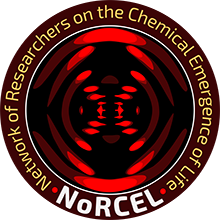Undifferentiated asteroids and comets are composed by primordial materials that were forming part of the protoplanetary disk. Some of the most pristine meteorites are the chondrites, and the carbonaceous ones host fascinating chemistry (Trigo-Rodríguez, 2015; Nittler et al., 2019). Some mineral phases contained in these rocks exhibit unique catalytic properties as we discovered in a series of experiments (Rotelli et al., 2016). I’d like to introduce in this talk the important implications of such properties for the unset of the origin of life on Earth during the early Archean. The Grand Tack Model (Walsh et al. 2011) is used to explain the main features observed in the distribution pattern of planets, and the current distribution of minor bodies in the main belt, among other observational evidence (see e.g. Morbidelli et al., 2012).
In such a scenario, an early period in planetary evolution, in which the final setting of Jupiter and Saturn naturally increased the flux of fragile volatile-rich bodies crossing the terrestrial planets. Direct impacts and close approaches of minor bodies with planets were far more usual at those remote ages, and delivered huge amounts of pristine materials to rocky planets. About 3.8 Gyrs ago the arrival of these bodies to the Earth-Moon binary system excavated big craters, but other fragile bodies carrying organics and water were probably fragmenting during close approaches to planets, and delivering their contents (Trigo-Rodríguez, 2017, 2019).
I have estimated that the early Earth was subjected to a meteoritic flux that could have well been at least 5-6 orders of magnitude the one at present. If that hypothesis is correct, huge amounts of chondritic materials could have reached the surfaces of the Earth, Mars and the rest of the planetary bodies at an annual rate of thousands of billions of metric tons. Was that event delivering essential components the key to promote the origin of life on Earth and perhaps other planetary bodies?
- Nittler L.R., Stoud, R.M., Trigo-Rodríguez, J.M., De Gregorio B.T., Alexander C.M.O’D., Davidson J., Moyano-Cambero C.E., and Tanbakouei, S. (2019) “A cometary building block in a primitive asteroidal meteorite”, Nature Astronomy, doi: 10.1038/s41550-019-0737-8, 8 pp.
- Morbidelli A., J.I. Lunine, D.P. O’Brien, S.N. Raymond, K.J. Walsh, Building Terrestrial planets. Annu. Rev. Earth Planet. Sci. 40, 251 (2012)
- Rotelli L. et al. (2016) Scientif. Rep. 6, doi:10.1038/srep38888.
- Trigo-Rodríguez J.M. (2015) In Planetary Mineralogy, EMU Notes in Mineralogy 15 pp. 67-87.
- Trigo-Rodríguez J.M. (2017) 48th LPSC, LPI Contribution No. 1964, id.1161.
- Trigo-Rodríguez J.M. (2019) The flux of meteoroids over time: meteor emission spectroscopy and the delivery of volatiles and chondritic materials to Earth. In “Hypersonic Meteoroid Entry Physics”, Colonna G., Capitelli M. and Laricchiuta A. (eds.), Institute of Physics Publishing, IOP Series in Plasma Physics, pp. 4-1/4-23. Online ISBN: 978-0-7503-1668-2.
- Walsh K.J., A. Morbidelli, S.N. Raymond, D.P. O’Brien, A.M. Mandell (2011) Nature 475, 206.


